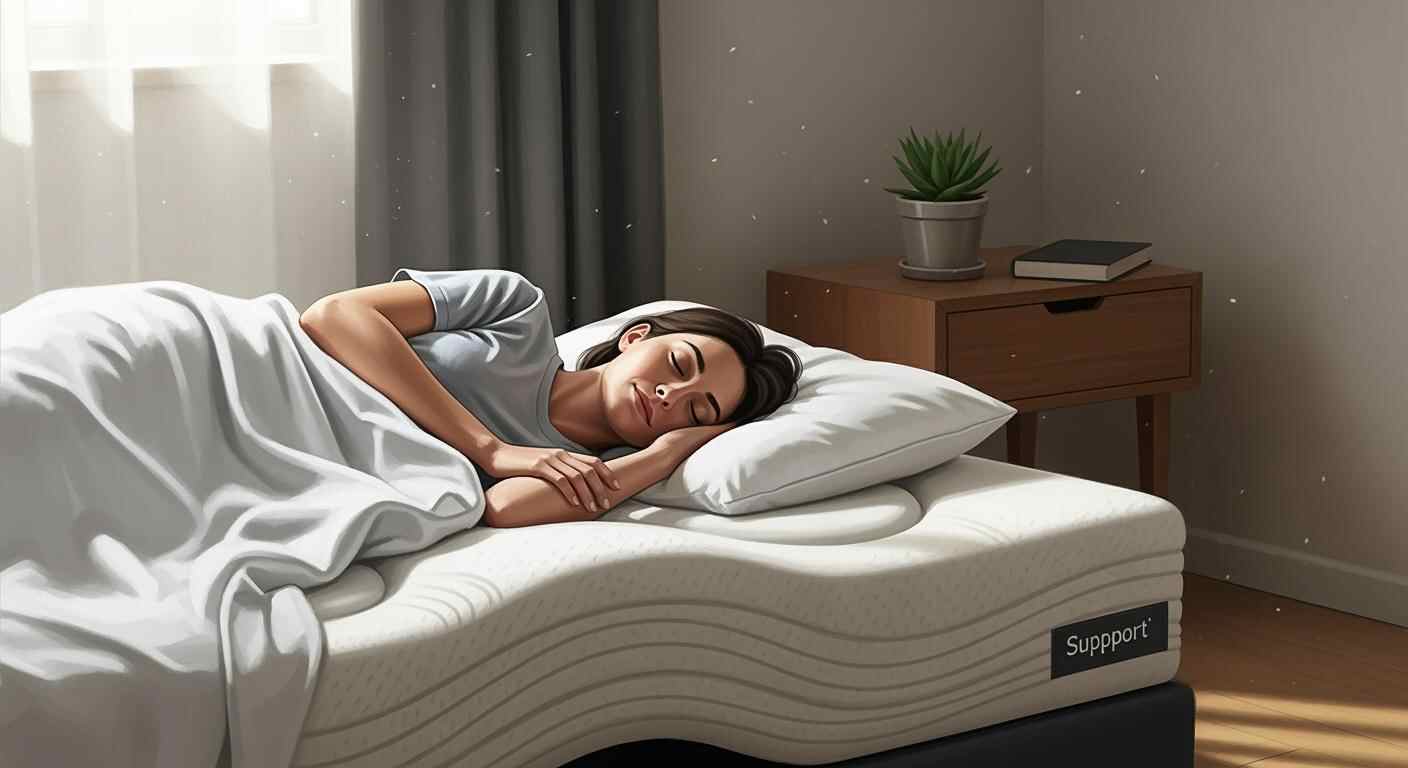Address
No.3 Chengcai Road, Leliu Town, Shunde District, Foshan City, Guangdong, China 528322
Address
No.3 Chengcai Road, Leliu Town, Shunde District, Foshan City, Guangdong, China 528322
An ergonomic mattress supports spinal alignment and relieves pressure points, helping you sleep better and wake up with less pain and stiffness.


An ergonomic mattress supports your body where it needs help most. It helps you sleep well at night. This mattress keeps your spine in a healthy spot. It also lowers pressure on your joints. If you use a mattress made for sleep ergonomics, you can get real health benefits. Studies say better sleep helps your heart. It makes your immune system stronger. It also lowers tiredness:
Health Outcome | Description |
|---|---|
Cardiovascular Health | Keeps heart rate and blood pressure normal. It lowers the chance of heart disease. |
Immune Function | Makes your immune system stronger. It helps you get sick less often. |
Overall Fatigue Levels | Helps your body recover. It lowers muscle and joint pain. |
Picking the right mattress can help you sleep better. It can ease pain and help you feel good every day.
An ergonomic mattress holds your body up. It helps keep your spine straight. It also lowers pressure on your joints. This can help you sleep better and stay healthy.
Picking a medium-firm mattress can help you fall asleep faster. It can also help you move less at night. This helps you sleep more deeply.
Look for things like a transition layer and neutral spinal alignment. Zoned layouts are also important. These features help make the mattress fit your body and feel comfortable.
Change your mattress every 7 to 10 years to keep good support. If you wake up with pain or see sagging, you may need a new mattress.
Think about your body type and how you sleep when picking a mattress. This helps you get the right support for a good night’s sleep.
You may ask how an ergonomic mattress is different. This mattress gives your body comfort and support. It helps you sleep in a healthy way all night. The mattress changes shape to fit your body. It supports your back, hips, and shoulders. These areas get the help they need.
Sleep health groups say an ergonomic mattress has special traits:
Characteristic | Description |
|---|---|
Balance between comfort and support | The mattress helps you stay in a good position all night. |
Alignment with natural contours | It matches your body’s shape to help you sleep well. |
Alleviation of pain | It can lower pain in your back, neck, and joints by giving support. |
An ergonomic mattress does more than feel soft. It supports your spine and keeps your body healthy.
Your spine should stay straight when you lie down. If your mattress is too soft or hard, your back may bend. This can cause pain. An ergonomic mattress helps keep your spine straight. It lowers the chance of waking up sore or stiff.
Tip: If you wake up with back pain, your mattress may not support your spine.
Studies say a medium-firm mattress helps you sleep better. People fall asleep faster and move less at night. For example:
A medium-firm mattress helps you fall asleep in about 8 minutes. A soft mattress takes over 12 minutes.
You move less on a medium-firm mattress, so you sleep deeper.
Your mattress should feel good and help your body rest. Sleep experts say the best ergonomic mattresses have special parts for comfort and support. Here are some important ones:
Feature | Description |
|---|---|
Transition Layer | This layer connects other layers and spreads your weight. |
Neutral Spinal Alignment | It keeps your spine in a healthy spot, which helps with back pain. |
Zoned Layouts | It gives extra support to places like your hips and back. |
Micro Coils | These coils move fast and help with pressure relief. |
These features help the mattress fit your body and give comfort. You get support where you need it most. This can help you wake up ready for the day.

There are big differences between these two mattress types. Standard mattresses use simple materials and designs. They do not think about how you sleep or your body shape. Ergonomic mattresses use better materials and special designs. These mattresses fit your body and help you rest well.
Feature | Standard Mattress | Ergonomic Mattress |
|---|---|---|
Design | Generic product | Tailored to specific needs |
Consideration of Sleep | Does not account for sleeping habits | Designed with body structure and habits in mind |
Durability | Less durable | More durable due to quality materials |
Support | Often insufficient support | Offers proper support with multiple layers |
Customization | Limited options | Various firmness levels and zones available |
Ergonomic mattresses give you more choices. They last longer and support your back and joints better.
You want a mattress that helps you feel good and sleep well. Studies show medium-firm and custom-inflated mattresses help with comfort and spinal alignment. These mattresses can lower pain and help you wake up feeling rested. The studies are good quality, so you can trust the results.
Evidence Type | Findings |
|---|---|
Mattress Design | Medium-firm and custom inflated mattresses are optimal for sleep comfort and spinal alignment. |
Study Quality | The methodological quality of the trials was moderate to high according to the PEDro scale. |
Temperature | Evidence regarding the optimal temperature for mattresses is insufficient, but warm temperatures are recommended. |
You might wonder about pressure relief. Research does not show which mattress is best for stopping pressure ulcers. More studies are needed to find the best mattress for comfort and healing.
Note: Ergonomic mattresses last longer than standard ones. Latex mattresses last 10 to 15 years. Innerspring mattresses last 7 to 10 years.
Some people believe things about mattresses that are not true. Here are some common myths:
Firm mattresses are always better for your back. The best mattress depends on your body and how you sleep.
Memory foam mattresses are hot and uncomfortable. New memory foam lets air move and keeps you cool.
A mattress should be perfectly flat. Adjustable mattresses help with spinal alignment and comfort.
You should pick a mattress that fits your needs, not just follow what others say.
You may notice pain in your back, neck, or joints when you wake up. An ergonomic mattress can help you prevent back pain and reduce pain and muscle stiffness. If you have chronic pain or posture problems, you need a mattress that gives you support and keeps your body in a natural position when sleeping. Studies show that sleeping on a medium to firm mattress can improve sleep quality and reduce neck and back pain. Mattresses that keep your spine neutral help lower stress on your back. One study found that people felt 18% less pain and 25% more comfort when using a special mattress compared to their old one.
People who benefit most from an ergonomic mattress include:
Older adults
Patients in hospice or long-term care
People with musculoskeletal pain
Those at risk of falls
If you have arthritis or scoliosis, you need a mattress that supports the health of your spine and joints. Mattresses like the WinkBed Plus use memory foam to cradle your joints and improve blood circulation. For scoliosis, a firmer mattress helps support your back and keeps your spine from curving more.
Your sleep position and body type affect which mattress is best for you. If you sleep on your back, you need a mattress that keeps your spine straight. Side sleepers need extra cushioning for their shoulders and hips. If you are taller or have a larger frame, you may need a bigger mattress for comfort.
Mattress Recommendation | |
|---|---|
Lower body weights | Medium-firm mattress |
Higher body weights | Firmer mattress |
Over 6 feet tall | Queen mattress or larger |
Larger frame | Upgrade mattress |
Choosing the right mattress helps you stay in a natural position when sleeping and can prevent back pain.
You may feel discomfort if your mattress does not fit your needs. An ergonomic mattress can reduce pain and muscle stiffness and help you wake up refreshed. If you have arthritis, look for a mattress with memory foam that cradles your joints. For scoliosis, sleep on your back or on the side of the main curve to keep your spine aligned. The WinkBed Luxury Firm mattress offers high pain relief and support for back alignment. When you use a mattress that fits your body, you improve blood circulation and sleep better.
Tip: If you wake up sore or tired, try a mattress that supports your body and keeps your spine in a healthy position.

When you choose an ergonomic mattress, you need to think about your body weight, sleep position, and health needs. Sleep specialists recommend looking at several important factors:
Quality of materials matters for durability and support.
Quality certifications show the mattress meets safety and health standards.
Warranty gives you peace of mind if something goes wrong.
Your individual needs, such as allergies or chronic pain, should guide your choice.
Return policy lets you try the mattress at home and return it if it does not suit you.
You should match the mattress to your body and sleeping habits. A good fit helps you get better rest and supports your health.
You want to make sure your mattress feels right before you buy it. Here are some tips for testing and evaluating:
Check support and comfort by lying down and noticing how your body feels. The inner core and base should support you, while the top layers should feel soft and comfortable.
Test the mattress yourself, since everyone has different preferences.
Use online reviews and trial periods to help you decide, because medical research does not always show which mattress works best for back pain.
Tip: Spend at least 10 minutes lying in your usual sleep position when testing a mattress in-store.
You need to replace your mattress to keep getting good support and sleep. Sleep experts suggest changing your mattress every 7 to 10 years. The type and quality of your mattress affect how long it lasts. Here are signs that show it is time for a new mattress:
You wake up with aches and pains.
Your mattress is older than 7–10 years.
You see sagging, lumps, or indentations.
You notice more allergy or asthma symptoms.
Your sleep quality gets worse, like tossing and turning.
Budget-friendly innerspring mattresses may last 5 to 7 years. High-quality mattresses can last 8 years or more. Hybrid beds often last 8 to 10 years, and natural latex beds can last up to 12 years with proper care.
You deserve a mattress that helps you feel your best every day. An ergonomic mattress gives your body the support it needs for healthy sleep. Take time to think about your comfort and health. If you wake up sore or tired, consider upgrading your mattress.
Good sleep can improve your mood, energy, and overall well-being for years to come.
An ergonomic mattress supports your body’s natural curves. It keeps your spine straight and reduces pressure on your joints. You get better sleep and less pain.
You may wake up with aches, stiffness, or numbness. Your mattress may sag or feel lumpy. If you toss and turn often, your mattress may not support you well.
Yes! An ergonomic mattress can reduce back pain. It supports your spine and keeps your body in a healthy position. You may notice less pain after a few nights.
Most ergonomic mattresses last 8 to 12 years. The lifespan depends on the materials and how you care for it. Rotate your mattress and keep it clean for best results.